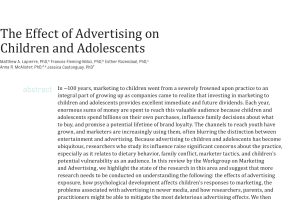Abstract
In ∼100 years, marketing to children went from a severely frowned upon practice to an integral part of growing up as companies came to realize that investing in marketing to children and adolescents provides excellent immediate and future dividends. Each year, enormous sums of money are spent to reach this valuable audience because children and adolescents spend billions on their own purchases, influence family decisions about what to buy, and promise a potential lifetime of brand loyalty. The channels to reach youth have grown, and marketers are increasingly using them, often blurring the distinction between entertainment and advertising. Because advertising to children and adolescents has become ubiquitous, researchers who study its influence raise significant concerns about the practice, especially as it relates to dietary behavior, family conflict, marketer tactics, and children’s potential vulnerability as an audience. In this review by the Workgroup on Marketing and Advertising, we highlight the state of the research in this area and suggest that more research needs to be conducted on understanding the following: the effects of advertising exposure, how psychological development affects children’s responses to marketing, the problems associated with advertising in newer media, and how researchers, parents, and practitioners might be able to mitigate the most deleterious advertising effects. We then present avenues of future research along with recommendations for key stakeholders.
This article was published in a special 2017 supplement of Pediatrics, a journal of the American Academy of Pediatrics. The supplement, “Children, Adolescents and Screens: What We Know and What We Need To Learn,” was produced by Children and Screens and includes the contributions of more than 130 interdisciplinary authors across 22 papers. See a complete list of articles included in the supplement.
